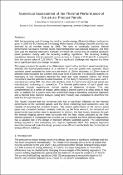Options
Numerical Asessment of The Thermal Performance of Structural Precast Panels
Date Issued
2012-05-29
Date Available
2013-01-21T16:52:47Z
Abstract
With the increasing cost of energy the need to provide energy efficient buildings continues to
grow. In 2003 the EU introduced the Energy Performance of Buildings Directive and this was
enforced by all member states by 2006. The need to continually improve thermal
performance has lead to member states implementing their own national initiatives, and from
next year the National Standards Authority of Ireland will specify that all certified sandwich
panel products comply with the incoming building regulations. The incoming building
regulations stipulate that all sandwich panels achieve a U-value of 0.15 W/m2K, a reduction
from the current value of 0.25 W/m2K. This is a significant challenge and requires that there
be no significant heat loss through the panel.
This paper presents the results of a collaborative project with a sandwich panel manufacturer
whereby the thermal performance of a number of concrete panels was assessed. Each
sandwich panel contained an inner concrete wythe of 150mm thickness, a 120mm layer of
phenolic foam insulation and a 90mm thick outer layer of concrete. For structural reasons it is
necessary to use connectors between the inner and outer concrete wythes, but these
connectors have the potential to allow heat loss. In this study 2 connector types were used: 1
manufactured using FRP, the other with stainless steel. A control (non-structural) panel was
manufactured containing no connectors. The thermal performance of each panel was
assessed through experimental hot-box testing to determine U-values. This was
complemented by a series of images taken using a thermal camera to show areas of heat
loss. In addition the U-values were also determined using a theoretical numerical approach
and a thermal finite element analysis (using MSC Patran) was conducted to determine the
heat flux through the panel.
The results showed that the connector type has a significant influence on the thermal
performance of the sandwich panels, and that those containing steel connectors were not
capable of providing the required U-value. The relative performance of the various panel
types was consistent between analysis methods, as the finite element, the numerical and
experimental approaches were in agreement. In addition, the heat losses observed through
the thermal imaging camera were consistent with the heat losses predicted by the finite
element analysis. It is proposed then that the use of numerical and finite element approaches
has a valuable role in the design of thermally efficient sandwich panels. The experimental
testing required is time consuming and requires significant effort. The analysis approach
described above will make the design process more efficient and facilitate the construction of
energy efficient buildings.
grow. In 2003 the EU introduced the Energy Performance of Buildings Directive and this was
enforced by all member states by 2006. The need to continually improve thermal
performance has lead to member states implementing their own national initiatives, and from
next year the National Standards Authority of Ireland will specify that all certified sandwich
panel products comply with the incoming building regulations. The incoming building
regulations stipulate that all sandwich panels achieve a U-value of 0.15 W/m2K, a reduction
from the current value of 0.25 W/m2K. This is a significant challenge and requires that there
be no significant heat loss through the panel.
This paper presents the results of a collaborative project with a sandwich panel manufacturer
whereby the thermal performance of a number of concrete panels was assessed. Each
sandwich panel contained an inner concrete wythe of 150mm thickness, a 120mm layer of
phenolic foam insulation and a 90mm thick outer layer of concrete. For structural reasons it is
necessary to use connectors between the inner and outer concrete wythes, but these
connectors have the potential to allow heat loss. In this study 2 connector types were used: 1
manufactured using FRP, the other with stainless steel. A control (non-structural) panel was
manufactured containing no connectors. The thermal performance of each panel was
assessed through experimental hot-box testing to determine U-values. This was
complemented by a series of images taken using a thermal camera to show areas of heat
loss. In addition the U-values were also determined using a theoretical numerical approach
and a thermal finite element analysis (using MSC Patran) was conducted to determine the
heat flux through the panel.
The results showed that the connector type has a significant influence on the thermal
performance of the sandwich panels, and that those containing steel connectors were not
capable of providing the required U-value. The relative performance of the various panel
types was consistent between analysis methods, as the finite element, the numerical and
experimental approaches were in agreement. In addition, the heat losses observed through
the thermal imaging camera were consistent with the heat losses predicted by the finite
element analysis. It is proposed then that the use of numerical and finite element approaches
has a valuable role in the design of thermally efficient sandwich panels. The experimental
testing required is time consuming and requires significant effort. The analysis approach
described above will make the design process more efficient and facilitate the construction of
energy efficient buildings.
Type of Material
Conference Publication
Copyright (Published Version)
2012, AFGC
Language
English
Status of Item
Not peer reviewed
Conference Details
Numerical Modeling Strategies for Sustainable Concrete Structures, Aix-en-Provence, France, May 29 - June 1, 2012
This item is made available under a Creative Commons License
File(s)
Loading...
Name
Keenahan.C.McNally.pdf
Size
768.16 KB
Format
Adobe PDF
Checksum (MD5)
03bcd6851944335f740a54ef5e51a7a8
Owning collection